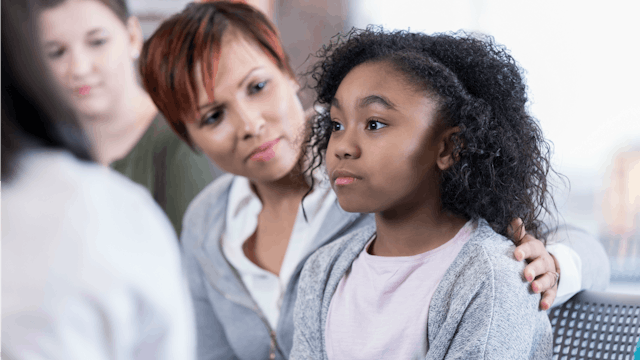3 Sentences That Can Help Your Kids Process Upsetting Events

When I was a teacher in an elementary school in Portland, a parent brought a loaded gun into our school during the Afterschool Program pick-up time. The gun accidentally went off in our cafeteria with 50 children waiting for their parents. This all too familiar scene of a school going on lock down with frantic parents standing outside in fear of what was going on inside was now happening at MY school. Luckily, no one was seriously hurt and business went on as usual as our society has become all too numb to gun violence in schools.
But as a teacher, the next day I had to face my class. It was my student’s mother who allegedly brought the gun into the school. While the staff protected the privacy of the student, 50 little witnesses, believe it or not, were having a difficult time keeping it to themselves.
I didn’t find out about the incident until 9:00 that night. While I knew I would need to serve as a model for how to act in real time, it was tricky because I was emotionally processing the events, too. My master’s degree curriculum, as good as it was, had not covered how to meet the emotional needs of children in this circumstance.
I knew only two things for certain: First, a gun going off in an elementary school is NOT normal. I refused to normalize this situation. And secondly, I had to be the leader and set the tone. I did not want to create more trauma than their little brains, or mine for that matter, could bear.
So I fell back on what all good teachers do: Meet the students where they are.
I started the day with normalcy so the students knew what to expect and could feel safe. We immediately went into our usual morning routine. We then met as an assembly where the principal spoke to the entire school. He carefully explained the events using words and concepts the children could understand. He reiterated that the students were safe.
As the principal was talking, it hit me that what these children needed was exactly what I needed: Steps on how to process this unexpected and awful information in my head. If we as teachers didn’t know how to deal with this, how could we expect our students to do it?
When we returned to the classroom, I wrote three sentence frames on the board:
When I first heard about it, I felt_____________.
After some time to think about it, I now feel ____________.
Today in order to feel safe, I need _____________________.
The order of these questions is important. First, it models how to talk about something without having to relive every detail. There might be a time and place for that, but not right away. The sentences needed to fall back on the emotions, not the gory details. In this way the children could personalize their experiences.We are all part of a community and even if all the students weren’t present when it happened, they are allowed to have feelings about it.
The second sentence demonstrates how emotions change. By teaching that emotions are fluid and like a wave that will pass, it offers peace in knowing that you won’t feel it forever. They could use this personal experience of their own to prove that.
The last sentence is crucial because it is empowering the children to say what they need and establish boundaries. They are advocating for themselves, and, if they didn’t know what they needed, they had the opportunity to listen to others and get ideas. It also told me how I could best serve them using their ideas to circle back and guide them.
I read the sentences aloud and modeled my own experience first. I told them: “When I first heard about it, I felt shocked because that happening is very unexpected. After some to think about it, I now feel sad but really thankful no one got hurt. Today, in order to feel safe, I need everyone to be really kind to each other and use calm voices.”
Next, we sat in a circle with a talking piece, and as we passed the baton around, each student spoke their truth as the others took turns listening. Every student said they felt affected by the event. Almost all knew what they needed and their descriptions about feeling safe were profound. Some wanted to keep doing normal work and some wanted to sit by the teacher. One student even asked me to lock our classroom door. They listened to each other and did their best to make everyone feel safe in our space.
As parents and teachers, we can’t save our children from all the bad things that happen in life. But we can teach them the tools to work through their own emotions and come out more resilient and compassionate.
This article was originally published on